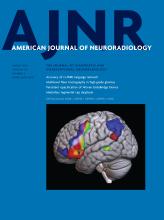Research ArticlePediatrics
Diagnostic Utility of 3D Gradient-Echo MR Imaging Sequences through the Filum Compared with Spin-Echo T1 in Children with Concern for Tethered Cord
F. Rafiee, W.A. Mehan, S. Rincon, S. Rohatgi, O. Rapalino and K. Buch
American Journal of Neuroradiology March 2023, 44 (3) 323-327; DOI: https://doi.org/10.3174/ajnr.A7791
F. Rafiee
aFrom the Department of Radiology, Massachusetts General Hospital, Harvard Medical School, Boston, Massachusetts
W.A. Mehan
aFrom the Department of Radiology, Massachusetts General Hospital, Harvard Medical School, Boston, Massachusetts
S. Rincon
aFrom the Department of Radiology, Massachusetts General Hospital, Harvard Medical School, Boston, Massachusetts
S. Rohatgi
aFrom the Department of Radiology, Massachusetts General Hospital, Harvard Medical School, Boston, Massachusetts
O. Rapalino
aFrom the Department of Radiology, Massachusetts General Hospital, Harvard Medical School, Boston, Massachusetts
K. Buch
aFrom the Department of Radiology, Massachusetts General Hospital, Harvard Medical School, Boston, Massachusetts

References
- 1.↵
- Lew SM,
- Kothbauer KF
- 2.↵
- Solmaz I,
- Izci Y,
- Albayrak B, et al
- 3.↵
- 4.↵
- Gharedaghi M,
- Samini F,
- Mashhadinejad H, et al
- 5.↵
- 6.↵
- 7.↵
- 8.↵
- Rohrschneider WK,
- Forsting M,
- Darge K, et al
- 9.↵
- 10.↵
- 11.↵
- 12.↵
- 13.↵
- 14.↵
- 15.↵
- 16.↵
- Wetzel SG,
- Johnson G,
- Tan AG, et al
- 17.↵
- 18.↵
- 19.↵
- 20.↵
- 21.↵
- 22.↵
- Murakami N,
- Morioka T,
- Hashiguchi K, et al
- 23.↵
- 24.↵
In this issue
American Journal of Neuroradiology
Vol. 44, Issue 3
1 Mar 2023
Advertisement
Diagnostic Utility of 3D Gradient-Echo MR Imaging Sequences through the Filum Compared with Spin-Echo T1 in Children with Concern for Tethered Cord
F. Rafiee, W.A. Mehan, S. Rincon, S. Rohatgi, O. Rapalino, K. Buch
American Journal of Neuroradiology Mar 2023, 44 (3) 323-327; DOI: 10.3174/ajnr.A7791
Jump to section
Related Articles
- No related articles found.
Cited By...
- No citing articles found.
This article has been cited by the following articles in journals that are participating in Crossref Cited-by Linking.
- Nadja Kadom, Kartik Reddy, Maxwell Cooper, Jack Knight-Scott, Richard Jones, Susan PalasisDiagnostics 2023 13 18
- Ali Ghasemi, Rodrigo Luna, Arvin Kheterpal, Patrick Debs, Laura FayadSkeletal Radiology 2024 53 6
- William A. Mehan Jr, Donghoon Shin, Karen BuchJournal of Computer Assisted Tomography 2024 48 5
- Hael Abdulrazeq, Owen P. Leary, Oliver Y. Tang, Helen Karimi, Abigail McElroy, Ziya Gokaslan, Michael Punsoni, John E. Donahue, Petra M. KlingeJournal of Clinical Medicine 2023 13 1
More in this TOC Section
Similar Articles
Advertisement






